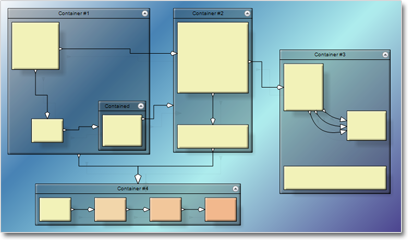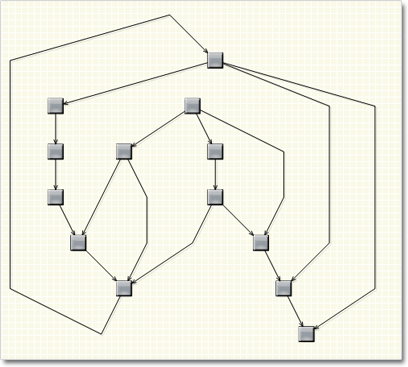We have just released a new version of the diagramming component for ASP.NET MVC. The new release contains new types of nodes, a new layout algorithm, styles, themes and more. Here are the details:
Table Nodes
Table cells can display text and/or image. The cells, columns and rows of a table have customizable style, image, text alignment and extents. The number of cells in a table’s grid can be changed programmatically. Tables with many rows can be scrolled.
Container Nodes
Container nodes contain other diagram nodes. When a container is moved, its children are moved too. Containers can be nested within each other to unlimited depth. They can be folded and unfolded. Nodes inside a container can be linked both inside and outside of it.
Styles and Themes
Instances of the new DiagramItem.Style class can be used to set the appearance of items as a single unit. If the Style of an item does not define value for one of its attributes, it is looked up in the styling hierarchy – in the Style of the diagram, in the current Theme or the set of default styles defined for each item class.
The “Styles and Themes” section in the online documentation provides useful team on how to use these new features.
Shadows
Diagram items can have shadows with customizable shadow color and offset.
One-way Layout
The OneWayLayout class ensures that links enter into nodes from the same direction and exit from the opposite side. If the graph contains cycles some links bend around their nodes to keep the enter/exit direction consistent. The algorithm aims to minimize the number of such links.
Parallel layouts (on server side)
The .NET 4 version of MindFusion.Diagramming takes advantage of the Task Parallel Library (TPL) to enable parallelism on the different layout algorithms. Set the EnableParallelism property on the Layout class to true to enable arranging different subgraphs on different threads to possibly improve performance on multiprocessor systems.
Preserve order in tree layout (on server side)
The Balance property of TreeLayout can be set to Preserve to keep the original geometric order of child nodes when arranging them under their parent. This can be used to arrange tree branches in a specific order by first positioning them in increasing horizontal or vertical positions.
More information about the new release is posted at the forum. You can download the trial version of the component from the link below:
Download MindFusion.Diagramming for ASP.NET MVC 1.4
About Diagramming for ASP.NET MVC Control: It is a multipurpose diagramming tool that consists of two parts: a .NET class library running on the server and a client side control implemented in JavaScript. The server side .NET library implements a flow-diagramming object model that lets you define structures such as trees, flowcharts and graphs. Every element in the diagram is easily accessible and the whole diagram is rendered as part of an HTML page by just calling the DiagramView extension method.
On the client the diagram is rendered by a DiagramView JavaScript control that draws its content on an HTML Canvas. The user is able to add nodes and links simply by drawing them with the mouse. There is also a NodeListView control, which lets users create new nodes via drag and drop.
MvcDiagram also supports various automatic layout algorithms that will make every diagram easy to understand and nice to look at. The diagram can also be easily serialized in binary or XML format. Exporting is done in a variety of formats including Pdf, Svg, Visio and more. You can read details about the components at the MvcDiagram features page.



